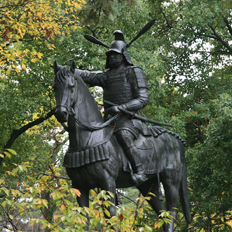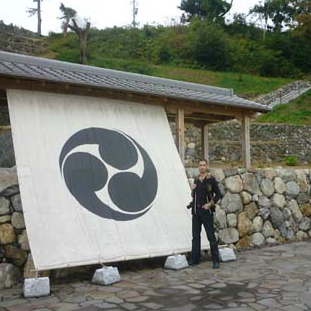「あの竹、茶道具に使えそう!」危険な戦場でも竹林に夢中な、ミスターへうげもの・古田重然(織部)
第三十回 SAMURAIファイル 古田重然
〈以下英訳〉
Furuta Shigenari is better remembered to history as Futruta Oribe, a samurai warrior, tea master, potter, and artist.
Born in 1544 in Motosu, Mino Province, (Gifu Prefecture) Oribe had many talents. He was originally a Tsukaiban (messenger) in the employ of Oda Nobunaga, reporting directly to his lord on the progress of battles, and his talent lay in explaining how a battle was faring.
He later met Sen no Rikyu, and became an apprentice to the great tea master. In fact, it was Oribe who influenced Rikyu in regards to seeing beauty in flaws, (wabisabi) and pointing out the marks, scars and impurities in the pottery that had until then been regarded as inferior. Oribe would become the leading tea master following Rikyu’s death, and was the instructor to the Shogun, Tokugawa Hidetada, as well as luminaries such as Kobori Enshu and Honami Koetsu!
Oribe created the Oribe-Ryu style of tea ceremony, and Oribe-yaki, a type of pottery famed for its use of dark green and brown on bone-white glaze, painted in geometric patterns.
The story goes that during the Siege of Osaka, while visiting the battle camp of Satake Yoshinobu, Oribe noticed a nearby bamboo grove with the right type and size of bamboo stalks for producing Chashaku, the small bamboo spatulas for scooping tea, and for making bamboo water dippers used during the tea ceremony. Excited by his discovery and forgetting that a battle was in progress, Oribe entered the bamboo grove in search of the perfect bamboo. An enemy sniper noticed someone moving in the grove, and seeing some light reflected of his naturally bald head, shot at Oribe! Bang! The lead shot from the matchlock gun grazed his head, Oribe was lucky to be alive. Oribe is said to have later joked that he “could no longer go anywhere without wearing a helmet anymore.”
In 1600, the former Toyotomi army general, Oribe, fought for the Eastern forces at Sekigahara with Satake Yoshinobu. In the 1615 Osaka campaign, Oribe was again on the side of Tokugawa Ieyasu, however he was accused of being involved in an assassination plot against Ieyasu, and for having passed information to those within Osaka Castle. True or not, for this, he and his son were ordered to commit seppuku, (or hara-kiri, ritual disembowelment) which he did in the proper samurai way. After that, the Tokugawa attempted to erase all memory of Oribe, banning his tea ceremony style, and his creative ceramics. In fact, the site of his former kiln was only rediscovered less than 80 years ago!
Furuta Oribe possessed both a creative spirit, and the cultural spirit of the samurai, and as such, greatly influenced Japanese culture. His participation in a number of battles, and the manner in which he died, committing seppuku, shows his true warrior spirit. Perhaps we, and history should better remember this remarkable man.
- 1
- 2







